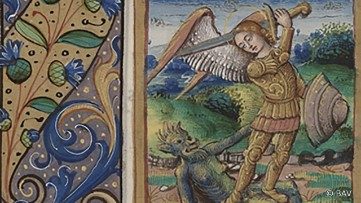ST. MICHAEL, ARCHANGEL-29 September
ST. MICHAEL, ARCHANGEL
And when we pass'd a little forth, I heard
A crying, "Blessed Mary! pray for us,
Michael and Peter! all ye saintly host!"
A crying, "Blessed Mary! pray for us,
Michael and Peter! all ye saintly host!"
(Dante, Purgatory, Canto XII, 51)
As he passes among the souls of the envious Purgatory, the great Christian poet Dante hears mysterious voices recalling examples of charity – the opposite of envy. Even among the suffering souls, whose eyes are sewn shut, litanies arise. They implore the intercession of the Blessed Virgin Mary, and immediately afterward – and before Peter and all the Saints – the name of “Michael.” In the previous canto, Dante had already seen the image of St Michael’s great antagonist, Lucifer, the “most noble” of the angels, who fell from heaven like lightning.
The sword against evil
Even in the Divine Comedy we see the comparison between Michael, described in the Bible as the head of the heavenly armies; and the leader of the angels who rose up against God, and were cast into Hell. St Michael is the Prince of Heavenly Hosts who fights against evil, defending the Church and the Faith against the assaults of Satan. And even Dante, in the 13th century, recognized the power of the intercession of St Michael, who is venerated in both East and West.
“Who is like unto God?”
One can hardly count the number of cathedrals, shrines, monasteries, chapels - but also mountains, caves and hills – named for St Michael the Archangel. The name “Michael,” which is mentioned five times in the Bible, is derived from a Hebrew expression meaning “Who is like unto God?”
The prayer of Pope Leo XIII
St Michael, the angelic warrior, is an incredibly popular saint, of whom numerous stories are told. One such story dates back to 13 October 1884.
The Pope at the time, Leo XIII, had just finished celebrating Mass at a chapel in the Vatican, when he paused for several minutes. His face, according to witnesses, showed both horror and wonder. Immediately afterward, Pope Leo went to his study, sat down at his desk, and wrote out a prayer to St Michael the Archangel. He then called his secretary and ordered him to make copies of the prayer, and have them sent to all the Bishops of the world, with the command to recite the prayer at the end of every Mass.
Pope Leo revealed that he had seen a chilling vision of “legions of demons” attacking the Church, and almost destroying it. Then he saw the St Michael intervening decisively to defend the Church – not immediately, but much later, and only after the faithful had multiplied their fervent prayers to the Archangel.
In our times, the custom of reciting the St Michael Prayer after Mass has fallen into disuse. But the custom was recalled by Saint John Paul II at the Regina Coeli on 24 April 1994: “Although today this prayer is no longer recited at the end of Mass,” he said, “I ask everyone not to forget it, and to recite it to obtain help in the battle against the forces of darkness and against the spirit of this world.”


Comments
Post a Comment